Peugeot Px10 1973
#1
Newbie
Thread Starter
Peugeot Px10 1973



I picked up a PX 10 that I believe is a 73. It has the 531 sticker on the down tube w Nervex Pro Lugs. Interesting the bike came w Normandy Hubs And Champion rims in size 27 1/4. I’m overhauling it now but I was surprised at the geometry. I have another 72 and the 73 seems more aggressive.
Looks like the PO had it built w 27 1/4 rims. The freewheel is a Maeda (suntour).
does anyone recall the park tool to remove the Maeda freewheel? Also if anyone remembers the bearing size would be great.
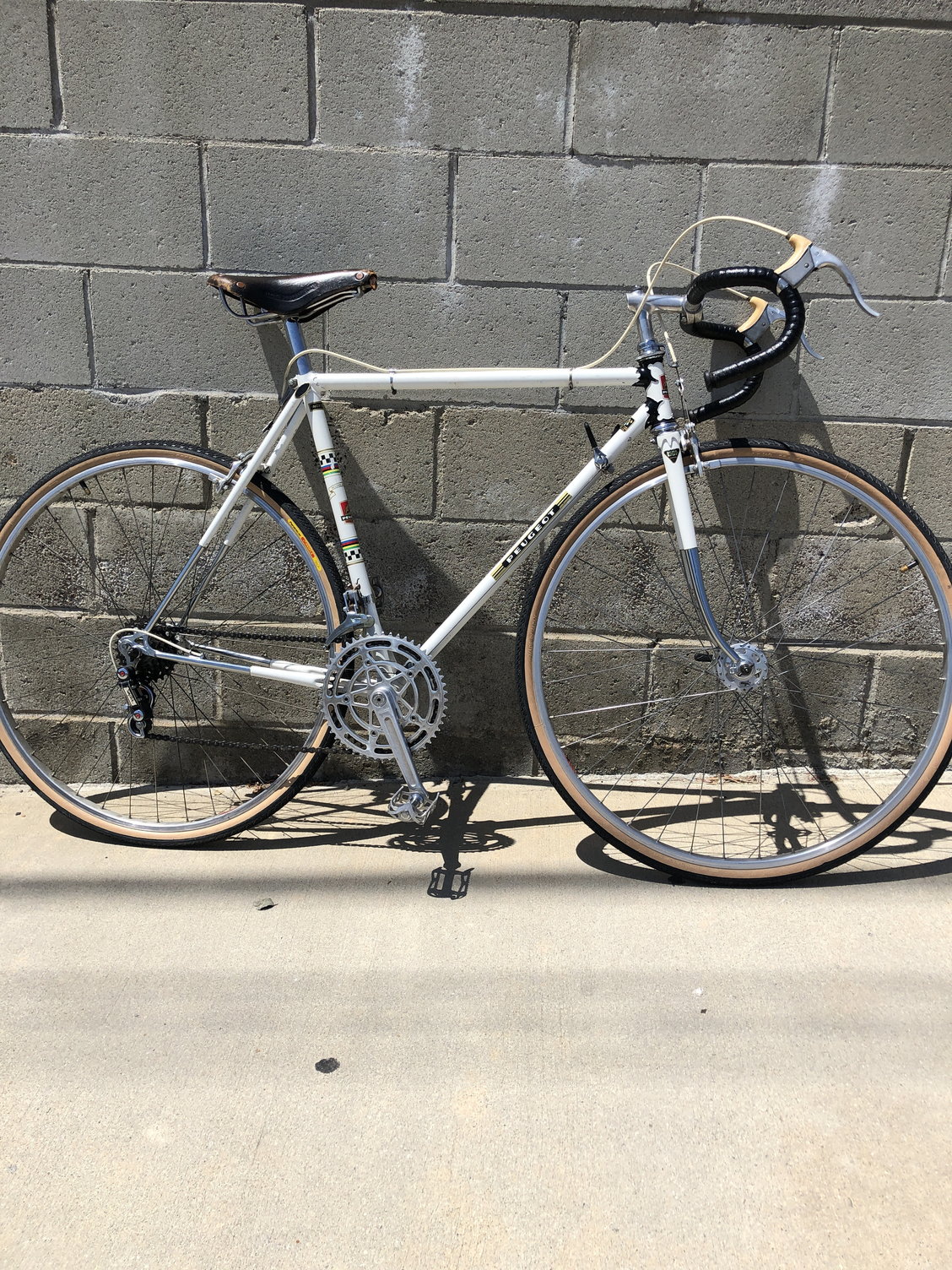
Pictures up as promised. So I wonder if this is a UX-10. The tire clearance is quite large.
Last edited by Cycologist; 05-16-20 at 09:12 PM.
#2
Senior Member
Join Date: Dec 2016
Location: Long Island, NY
Posts: 2,107
Bikes: Trek 800 x 2, Schwinn Heavy Duti, Schwinn Traveler, Schwinn Le Tour Luxe, Schwinn Continental, Cannondale M400 and Lambert, Schwinn Super Sport
Mentioned: 14 Post(s)
Tagged: 0 Thread(s)
Quoted: 809 Post(s)
Liked 1,018 Times
in
664 Posts
The freewheel tool is Park FR-2. It is also available from other tool makers as well. It is most likely the two prong tool. Check your freewheel before you buy it.
Park FR-2
Waiting for pictures.
Park FR-2
Waiting for pictures.
#3
spondylitis.org
Join Date: Mar 2013
Location: Fleetwood, PA, USA
Posts: 1,002
Bikes: '84 Colnago Super; '90 Bridgestone MB-1; '81 Trek 930; '01 Cinelli Supercorsa; '62 Ideor Asso; '87 Tommasini Super Prestige; '13 Lynskey R2300; '84 Serotta Nova Special; '94 Litespeed Catalyst; etc.
Mentioned: 10 Post(s)
Tagged: 0 Thread(s)
Quoted: 121 Post(s)
Liked 97 Times
in
63 Posts
Horrifying.
PX-10s and PY-10s ought to be on tubulars.
Preferably Mavic Monthlerys. With Campagnolo NR hubs.
PX-10s and PY-10s ought to be on tubulars.
Preferably Mavic Monthlerys. With Campagnolo NR hubs.
#4
verktyg
Join Date: Jul 2006
Location: SF Bay Area
Posts: 4,030
Bikes: Current favorites: 1988 Peugeot Birraritz, 1984 Gitane Super Corsa, 1980s DeRosa, 1981 Bianchi Campione Del Mondo, 1992 Paramount OS, 1988 Colnago Technos, 1985 RalieghUSA SBDU Team Pro
Mentioned: 207 Post(s)
Tagged: 0 Thread(s)
Quoted: 1036 Post(s)
Liked 1,237 Times
in
653 Posts
Bearing Size?
I picked up a PX 10 that I believe is a 73. It has the 531 sticker on the down tube w Nervex Pro Lugs. Interesting the bike came w Normandy Hubs And Champion rims in size 27 1/4. I’m overhauling it now but I was surprised at the geometry. I have another 72 and the 73 seems more aggressive.
Looks like the PO had it built w 27 1/4 rims. The freewheel is a Maeda (suntour).
does anyone recall the park tool to remove the Maeda freewheel? Also if anyone remembers the bearing size would be great.
pics to follow
Looks like the PO had it built w 27 1/4 rims. The freewheel is a Maeda (suntour).
does anyone recall the park tool to remove the Maeda freewheel? Also if anyone remembers the bearing size would be great.
pics to follow
PX-10 bikes came with Normandy Luxe Competition hubs up through about 1974 when they switched to Maillard 700 hubs. They would have had metric threaded freewheels.
Easy was to tell the Luxe Competition hubs is they don't have removable dust shields. Also they have red or gold foil stickers around the center of the hubs.
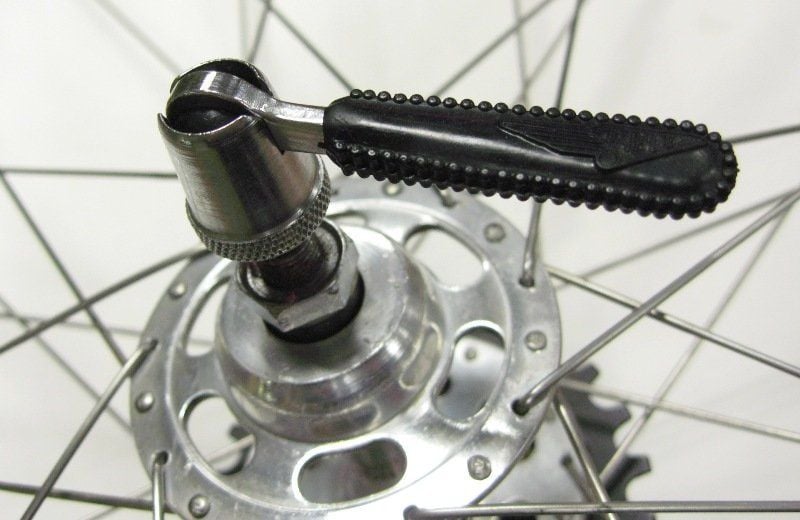

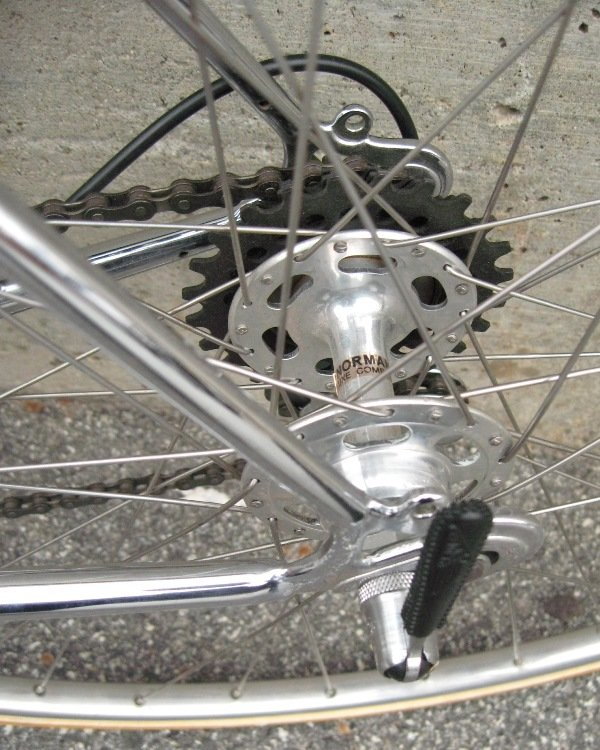
They were fairly decent mid range quality hubs, better than say Campy Nuovo Tipo hubs. The problem was they used hard to get proprietary cones. We used to get them from the Peugeot dealer a few block from our shop. By ~1975 they couldn't even get them through Peugeot.
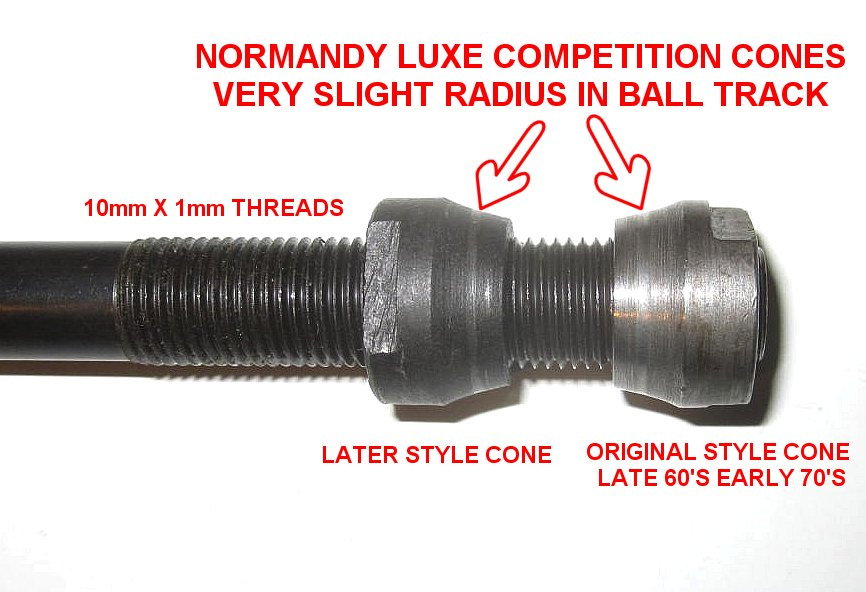
If you have those hubs, they use 12 3/16" balls in the front and 9 1/4" balls in the rear.
My 1967 PX-10 barn bike came with 2 sets of wheels: the original tubulars with Normandy Luxe Competition hubs plus a set of 27" clinchers with Normandy Sport hubs, the ones that came on millions of lower priced bikes from the late 60's into the early 80's. They had removable dust shields.
Normandy Sport Hubs
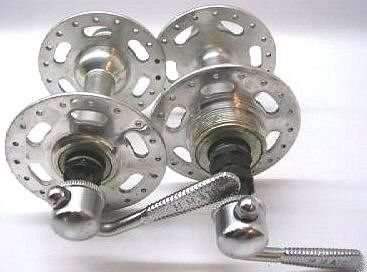
Those hubs used 10 3/16" balls in the front and 9 1/4" balls in the rear.
The clincher wheels had some really cheap 27" x 1" tires. I picked up some 27" x 1 1/4" Paselas. No go, had to return them for 27" x 1 1/8" tires and they were a tight fit.
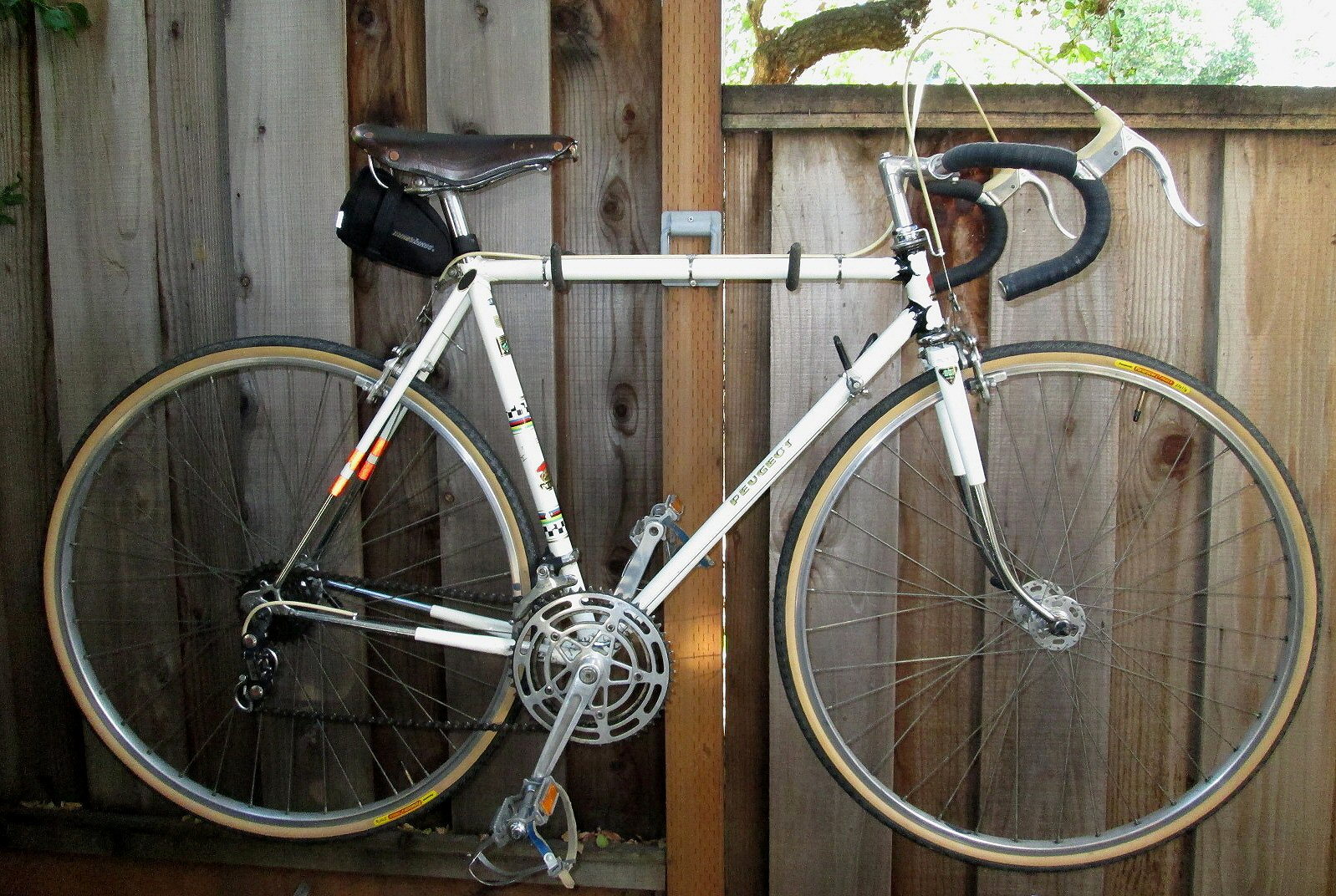
Peugeot offered the UX-10 model for the US market that came with 27" x 1 1/4" clinchers. They probably added additional clearance in those frames for 27" clinchers.
verktyg

__________________
Don't believe everything you think! History is written by those who weren't there....
Chas. ;-)
Don't believe everything you think! History is written by those who weren't there....
Chas. ;-)
Last edited by verktyg; 05-09-20 at 05:01 AM.
Likes For verktyg:
#5
Newbie
Thread Starter
Bearing size for which component/components?
PX-10 bikes came with Normandy Luxe Competition hubs up through about 1974 when they switched to Maillard 700 hubs. They would have had metric threaded freewheels.
Easy was to tell the Luxe Competition hubs is they don't have removable dust shields. Also they have red or gold foil stickers around the center of the hubs.



They were fairly decent mid range quality hubs, better than say Campy Nuovo Tipo hubs. The problem was they used hard to get proprietary cones. We used to get them from the Peugeot dealer a few block from our shop. By ~1975 they couldn't even get them through Peugeot.

If you have those hubs, they use 12 3/16" balls in the front and 9 1/4" balls in the rear.
My 1967 PX-10 barn bike came with 2 sets of wheels: the original tubulars with Normandy Luxe Competition hubs plus a set of 27" clinchers with Normandy Sport hubs, the ones that came on millions of lower priced bikes from the late 60's into the early 80's. They had removable dust shields.
Normandy Sport Hubs

Those hubs used 10 3/16" balls in the front and 9 1/4" balls in the rear.
The clincher wheels had some really cheap 27" x 1" tires. I picked up some 27" x 1 1/4" Paselas. No go, had to return them for 27" x 1 1/8" tires and they were a tight fit.

Peugeot offered the UX-10 model for the US market that came with 27" x 1 1/4" clinchers. They probably added additional clearance in those frames for 27" clinchers.
verktyg
PX-10 bikes came with Normandy Luxe Competition hubs up through about 1974 when they switched to Maillard 700 hubs. They would have had metric threaded freewheels.
Easy was to tell the Luxe Competition hubs is they don't have removable dust shields. Also they have red or gold foil stickers around the center of the hubs.



They were fairly decent mid range quality hubs, better than say Campy Nuovo Tipo hubs. The problem was they used hard to get proprietary cones. We used to get them from the Peugeot dealer a few block from our shop. By ~1975 they couldn't even get them through Peugeot.

If you have those hubs, they use 12 3/16" balls in the front and 9 1/4" balls in the rear.
My 1967 PX-10 barn bike came with 2 sets of wheels: the original tubulars with Normandy Luxe Competition hubs plus a set of 27" clinchers with Normandy Sport hubs, the ones that came on millions of lower priced bikes from the late 60's into the early 80's. They had removable dust shields.
Normandy Sport Hubs

Those hubs used 10 3/16" balls in the front and 9 1/4" balls in the rear.
The clincher wheels had some really cheap 27" x 1" tires. I picked up some 27" x 1 1/4" Paselas. No go, had to return them for 27" x 1 1/8" tires and they were a tight fit.

Peugeot offered the UX-10 model for the US market that came with 27" x 1 1/4" clinchers. They probably added additional clearance in those frames for 27" clinchers.
verktyg

The simplex pulleys are toast and have been reduced to small bulls eyes.
The hubs do have the foil stickers. Bike is almost out together. I ordered the Pasaelas 27 1/4 I hope those fit
I saved an old set of tubulars so it seems the Px10 was interchangeable with 27” rims and 700c if I’m correct
.
Last edited by Cycologist; 05-09-20 at 09:39 AM.
#6
feros ferio
Join Date: Jul 2000
Location: www.ci.encinitas.ca.us
Posts: 21,793
Bikes: 1959 Capo Modell Campagnolo; 1960 Capo Sieger (2); 1962 Carlton Franco Suisse; 1970 Peugeot UO-8; 1982 Bianchi Campione d'Italia; 1988 Schwinn Project KOM-10;
Mentioned: 44 Post(s)
Tagged: 0 Thread(s)
Quoted: 1390 Post(s)
Liked 1,322 Times
in
835 Posts
Based on my experience with my 1980 PKN-10, 700C clinchers are definitely the way to go if you are averse to tubular tires. I could barely accommodate a 27"x1" tire in front, but I can go as high as 700Cx35, which obviously opens up a wide range of choices, limited only by rim width.
__________________
"Far and away the best prize that life offers is the chance to work hard at work worth doing." --Theodore Roosevelt
Capo: 1959 Modell Campagnolo, S/N 40324; 1960 Sieger (2), S/N 42624, 42597
Carlton: 1962 Franco Suisse, S/N K7911
Peugeot: 1970 UO-8, S/N 0010468
Bianchi: 1982 Campione d'Italia, S/N 1.M9914
Schwinn: 1988 Project KOM-10, S/N F804069
"Far and away the best prize that life offers is the chance to work hard at work worth doing." --Theodore Roosevelt
Capo: 1959 Modell Campagnolo, S/N 40324; 1960 Sieger (2), S/N 42624, 42597
Carlton: 1962 Franco Suisse, S/N K7911
Peugeot: 1970 UO-8, S/N 0010468
Bianchi: 1982 Campione d'Italia, S/N 1.M9914
Schwinn: 1988 Project KOM-10, S/N F804069
#7
verktyg
Join Date: Jul 2006
Location: SF Bay Area
Posts: 4,030
Bikes: Current favorites: 1988 Peugeot Birraritz, 1984 Gitane Super Corsa, 1980s DeRosa, 1981 Bianchi Campione Del Mondo, 1992 Paramount OS, 1988 Colnago Technos, 1985 RalieghUSA SBDU Team Pro
Mentioned: 207 Post(s)
Tagged: 0 Thread(s)
Quoted: 1036 Post(s)
Liked 1,237 Times
in
653 Posts
Not All PX-10 Were Equal
is it possible I have a UX10 vs the PX10. Forks and frame all have 531 Reynolds stickers. The picture above is UX10? How else can you identify a UX? Maybe it was a rim designation only.
The hubs do have the foil stickers. Bike is almost all together. I ordered the Pasaelas 27 1/4 I hope those fit. I saved an old set of tubulars so it seems the Px10 was interchangeable with 27” rims and 700c if I’m correct.
The hubs do have the foil stickers. Bike is almost all together. I ordered the Pasaelas 27 1/4 I hope those fit. I saved an old set of tubulars so it seems the Px10 was interchangeable with 27” rims and 700c if I’m correct.
I've only seen one reference to a UX-10 and that was in the 1974 Peugeot US Catalog. There were some PX-10 variants that had different suffix letters indicating clinchers but I can't locate that info: PX-10xx???

Read my post from 2015: https://www.bikeforums.net/18646851-post8.html
How my 1967 barn bike looked when I brought it home. It had the 27" wheels installed instead of the sewups. As I mentioned, the original clinchers were 27" x 1". Silly me, I figured that I could just go up to 27" x 1 1/4" tires. They wouldn't even go into the front or rear. 27" x 1 1/8" barely fit.

Original 27" x 1" tires.
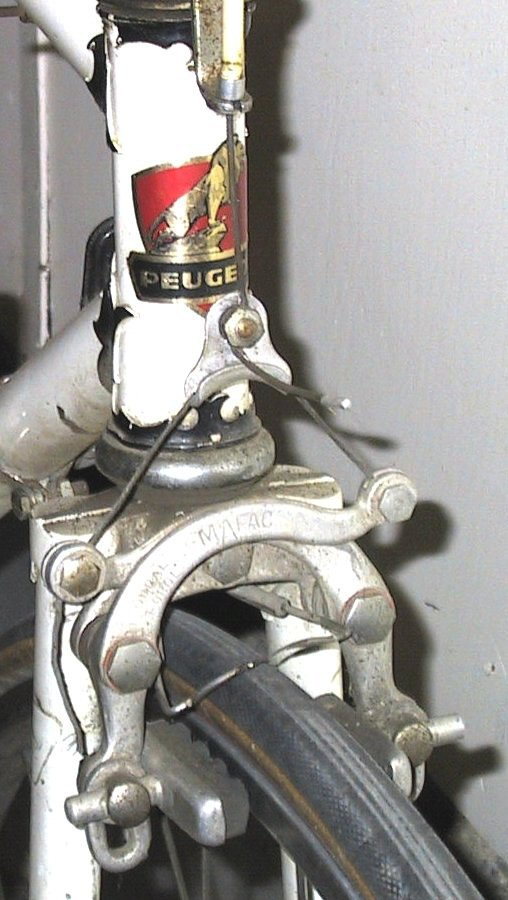
With 27" x 1 1/8" tires. I think that I had to deflate the rear tire to get it in. Notice how close the rear tire is to the brake bridge.
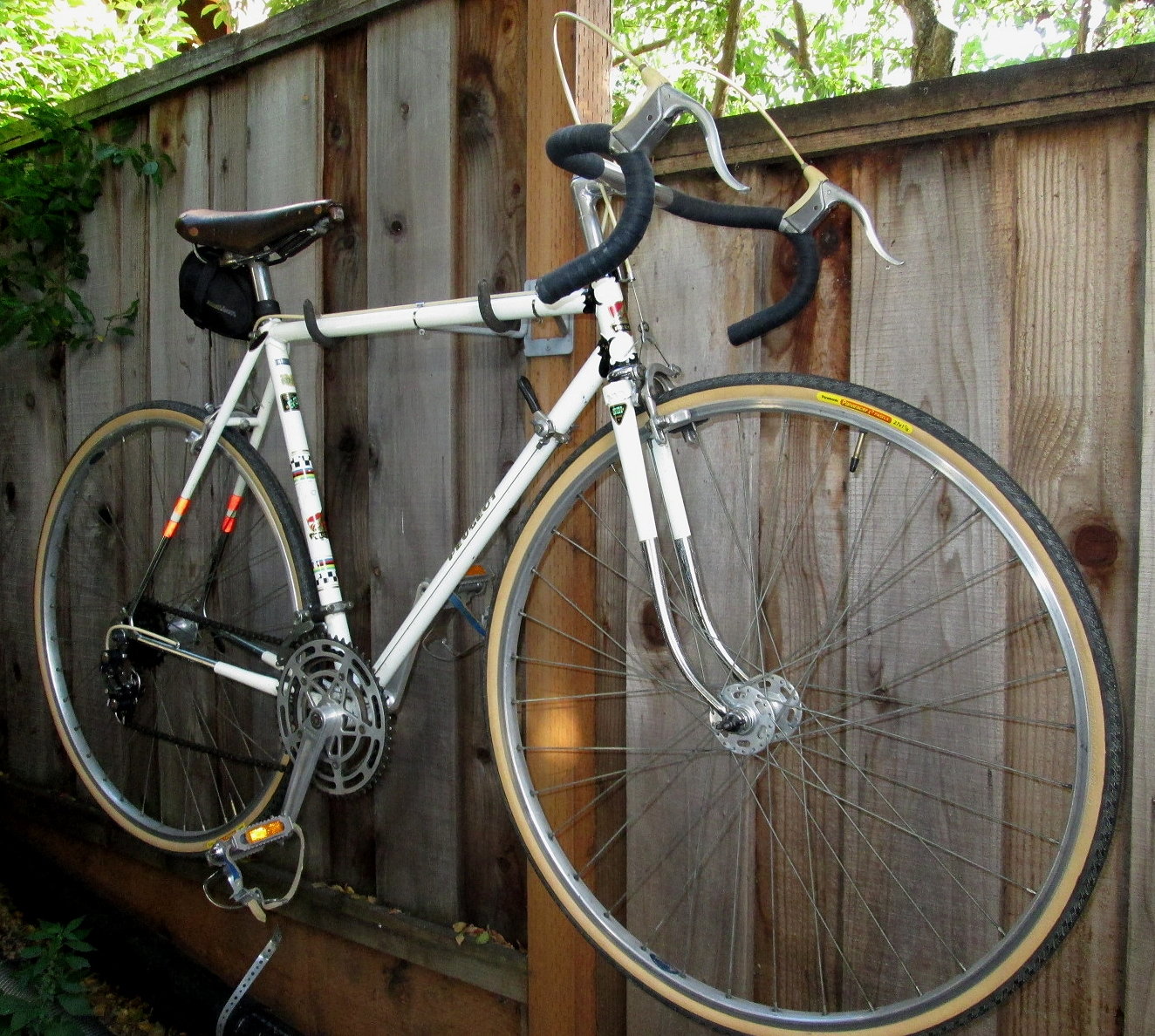

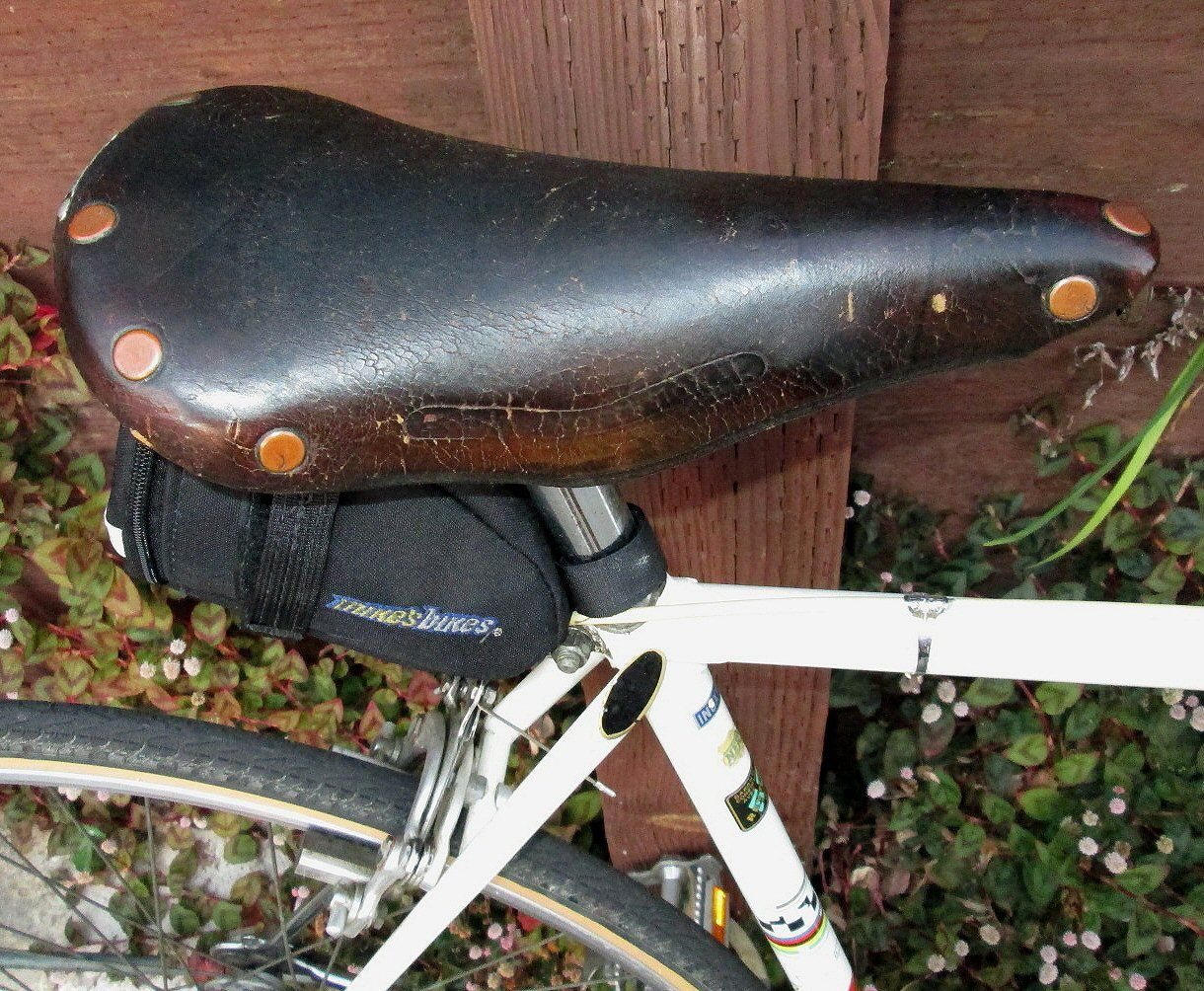
The 27" x 1 1/8" front tire barely clears the brake caliper and fork crown.

NOTE: I've since switched to 700c x 25mm wheels and tires. Since the bike was made for sewups (700c size) there's no longer a clearance problem.
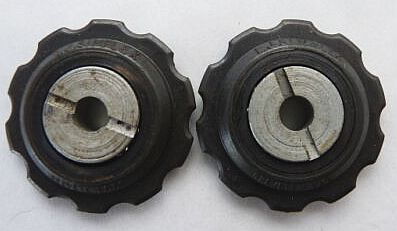
You can get these Shimano 7 speed pulleys in the link below for $10-$15 dollars. They fit Simplex RDs without any problem:
https://www.ebay.com/itm/2-New-Vinta...UAAOSwBsld4ygj
Two Birds with one stone!
Based on my experience with my 1980 PKN-10, 700C clinchers are definitely the way to go if you are averse to tubular tires. I could barely accommodate a 27"x1" tire in front, but I can go as high as 700Cx35, which obviously opens up a wide range of choices, limited only by rim width.
27" wheels were a US/UK/Canadian standard. Please see my notes above.
During the US Bike Boom FAD, 1970 to mid 1974, a lot of bike purchases were impulse buys. Typical situation, Saturday afternoon an affluent customer (by European standards) walks into a bike shop and says "I want the best bike you have" (read rampant consumerism - most expensive bike, fastest car, biggest pick-em-up truck and so on).
Very few of those folks were tolerant or patient enough to take the time to learn the nuances of a competition bike. The buzz word was "10 Speed Racing Bike". The "best bikes" came with sewups. After several flats, they came back to the shop and had the wheels changed to clinchers which meant 27" wheels. 700c size wheels didn't become common place in the US market until after the mid to late 70's.
Some smart marketoids like Ben Lawee who was the Motobecane importer started having better models equipped with clinchers rather than sewups. Same thing probably happened with the UX-10 ("U" indicationg US market).
Add to that, there were NO dimensional standards for most bikes. I've seen PX-10s with enough frame clearance to fit 27" x 1 1/4" wheels which makes most 700c tires an easy fit. We sold Gitanes in the early 70's and saw the same variances. Some would take 27" wheels and some wouldn't....
Remember... Is it wrong... or just French!
verktyg

__________________
Don't believe everything you think! History is written by those who weren't there....
Chas. ;-)
Don't believe everything you think! History is written by those who weren't there....
Chas. ;-)
Last edited by verktyg; 05-09-20 at 05:21 PM.
Likes For verktyg:
#8
feros ferio
Join Date: Jul 2000
Location: www.ci.encinitas.ca.us
Posts: 21,793
Bikes: 1959 Capo Modell Campagnolo; 1960 Capo Sieger (2); 1962 Carlton Franco Suisse; 1970 Peugeot UO-8; 1982 Bianchi Campione d'Italia; 1988 Schwinn Project KOM-10;
Mentioned: 44 Post(s)
Tagged: 0 Thread(s)
Quoted: 1390 Post(s)
Liked 1,322 Times
in
835 Posts
Remember... Is it wrong... or just French!
Reminds me of "it's not a bug ... it's a feature."
Reminds me of "it's not a bug ... it's a feature."
__________________
"Far and away the best prize that life offers is the chance to work hard at work worth doing." --Theodore Roosevelt
Capo: 1959 Modell Campagnolo, S/N 40324; 1960 Sieger (2), S/N 42624, 42597
Carlton: 1962 Franco Suisse, S/N K7911
Peugeot: 1970 UO-8, S/N 0010468
Bianchi: 1982 Campione d'Italia, S/N 1.M9914
Schwinn: 1988 Project KOM-10, S/N F804069
"Far and away the best prize that life offers is the chance to work hard at work worth doing." --Theodore Roosevelt
Capo: 1959 Modell Campagnolo, S/N 40324; 1960 Sieger (2), S/N 42624, 42597
Carlton: 1962 Franco Suisse, S/N K7911
Peugeot: 1970 UO-8, S/N 0010468
Bianchi: 1982 Campione d'Italia, S/N 1.M9914
Schwinn: 1988 Project KOM-10, S/N F804069
#9
Senior Member
The mid '70s UX10 that I recently rebuilt. I have never ridden it because it is way too small. I will pass it on at some point.


I should have made it clearer in my post above. My 1967 all original barn bike was a PX-10 not a UX-10.
I've only seen one reference to a UX-10 and that was in the 1974 Peugeot US Catalog. There were some PX-10 variants that had different suffix letters indicating clinchers but I can't locate that info: PX-10xx???

verktyg
I've only seen one reference to a UX-10 and that was in the 1974 Peugeot US Catalog. There were some PX-10 variants that had different suffix letters indicating clinchers but I can't locate that info: PX-10xx???

verktyg

Likes For rjhammett:
#10
verktyg
Join Date: Jul 2006
Location: SF Bay Area
Posts: 4,030
Bikes: Current favorites: 1988 Peugeot Birraritz, 1984 Gitane Super Corsa, 1980s DeRosa, 1981 Bianchi Campione Del Mondo, 1992 Paramount OS, 1988 Colnago Technos, 1985 RalieghUSA SBDU Team Pro
Mentioned: 207 Post(s)
Tagged: 0 Thread(s)
Quoted: 1036 Post(s)
Liked 1,237 Times
in
653 Posts
Ux-10 ?
As I mentioned above, I've only seen one reference to a UX-10 and that was in the 1974 Peugeot US catalog.
Ah Yes, it's all coming back to me... We had this discussion last year...
https://www.bikeforums.net/classic-v...l-peugeot.html
BTW, really nice restoration!

For the benefit of others:
Looking at the fork crown, suggests to me that the frame is a PR-10. Easy way to tell. PR-10 forks were made of rolled sheet metal like U-08 forks rather than tubing. Look for a seam running down the back of the blades. I've never seen a failure in any of these forks but if they ever get bent, don't try to straighten them. They will split down the seam like a banana peel!
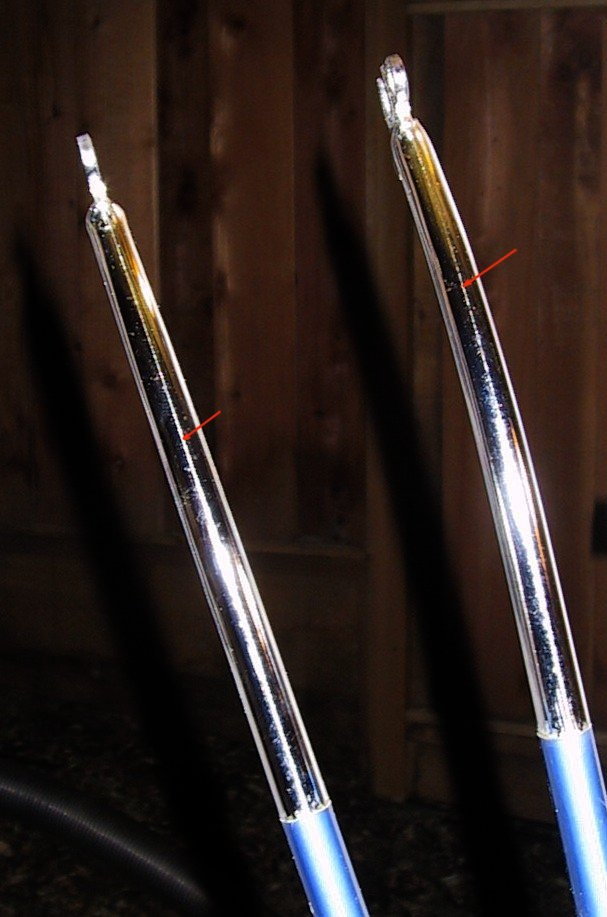
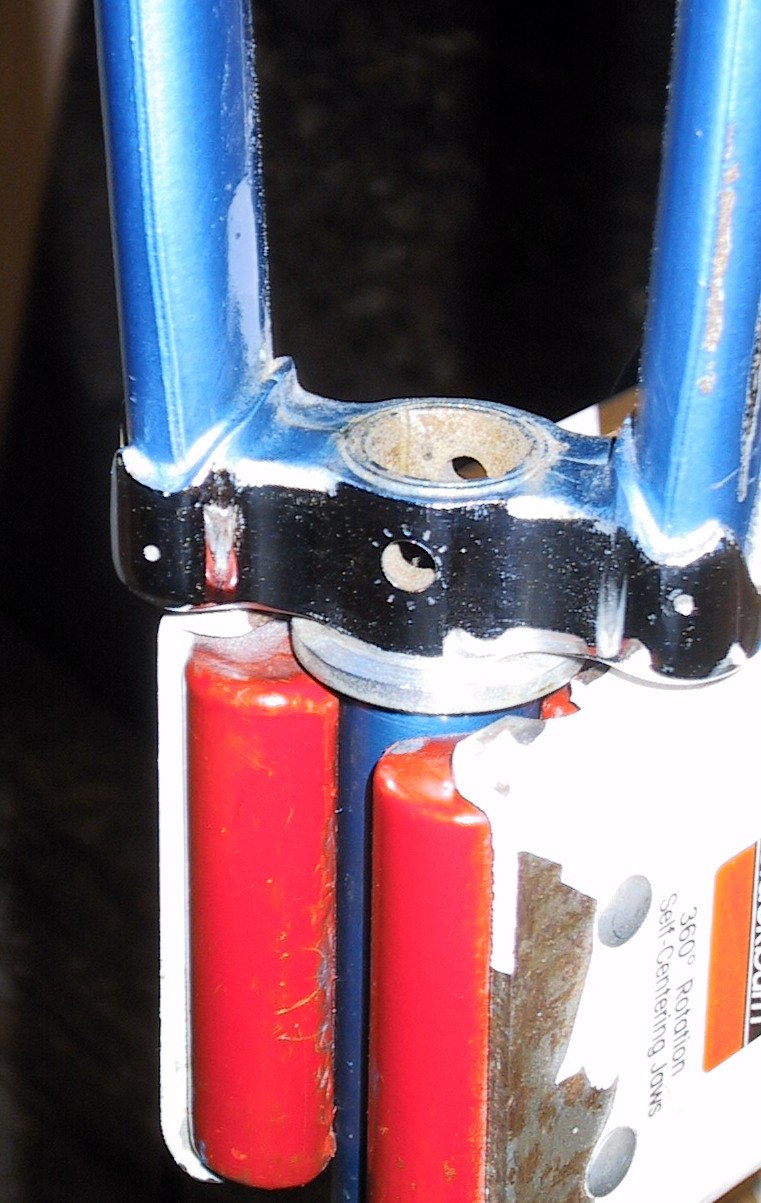
There was one other model, the PX-60 Cyclotourisme Gentleman which was a touring version on the PX-10. They came with fender clearance, Stronglight 99 cranks plus lights and fenders from the factory.

verktyg

__________________
Don't believe everything you think! History is written by those who weren't there....
Chas. ;-)
Don't believe everything you think! History is written by those who weren't there....
Chas. ;-)
#11
verktyg
Join Date: Jul 2006
Location: SF Bay Area
Posts: 4,030
Bikes: Current favorites: 1988 Peugeot Birraritz, 1984 Gitane Super Corsa, 1980s DeRosa, 1981 Bianchi Campione Del Mondo, 1992 Paramount OS, 1988 Colnago Technos, 1985 RalieghUSA SBDU Team Pro
Mentioned: 207 Post(s)
Tagged: 0 Thread(s)
Quoted: 1036 Post(s)
Liked 1,237 Times
in
653 Posts
Addendum On PX-10 Info
I forgot about this website. Unfortunately the original version had a lot more historical info that got lost:
PX-10_History
verktyg
PX-10_History
verktyg

__________________
Don't believe everything you think! History is written by those who weren't there....
Chas. ;-)
Don't believe everything you think! History is written by those who weren't there....
Chas. ;-)
#12
Senior Member
#13
aka Tom Reingold
Join Date: Jan 2009
Location: New York, NY, and High Falls, NY, USA
Posts: 40,495
Bikes: 1962 Rudge Sports, 1971 Raleigh Super Course, 1971 Raleigh Pro Track, 1974 Raleigh International, 1975 Viscount Fixie, 1982 McLean, 1996 Lemond (Ti), 2002 Burley Zydeco tandem
Mentioned: 511 Post(s)
Tagged: 0 Thread(s)
Quoted: 7341 Post(s)
Liked 2,440 Times
in
1,424 Posts
@verktyg, I bought a PXN-10LE in 1979. I think the 'N' meant no tubulars, but it might have been the 'LE' that meant that.
__________________
Tom Reingold, tom@noglider.com
New York City and High Falls, NY
Blogs: The Experienced Cyclist; noglider's ride blog
“When man invented the bicycle he reached the peak of his attainments.” — Elizabeth West, US author
Please email me rather than PM'ing me. Thanks.
Tom Reingold, tom@noglider.com
New York City and High Falls, NY
Blogs: The Experienced Cyclist; noglider's ride blog
“When man invented the bicycle he reached the peak of his attainments.” — Elizabeth West, US author
Please email me rather than PM'ing me. Thanks.
#14
Ride, Wrench, Swap, Race
Join Date: Jan 2010
Location: Northern California
Posts: 9,181
Bikes: Cheltenham-Pedersen racer, Boulder F/S Paris-Roubaix, Varsity racer, '52 Christophe, '62 Continental, '92 Merckx, '75 Limongi, '76 Presto, '72 Gitane SC, '71 Schwinn SS, etc.
Mentioned: 132 Post(s)
Tagged: 0 Thread(s)
Quoted: 1562 Post(s)
Liked 1,285 Times
in
856 Posts
Pasela tires in 27" sizes run one full size larger than many other brands of tires.
I've been doing all of my gravel riding this year (including large-scale stuff) using Pasela tires in their 27x1" size, which plump to 26mm on decently-wide old Araya rims.
Other 27x1" tires measure as small as 21mm in mounted width, and some of these bear the size designation "20-630" indicating a 20mm nominal width.
There were a couple of different fork crowns used on similar PX10's leaving the factory as witnessed in a previous BF thread on the PX10 subject.
The steeper-angled PX10 and PX10LE frames beginning in 1973 were a good couple of degrees steeper than those produced through 1972.
This is really aggressive geometry that better supports a more rider-forward position using a longer stem, which calms the steering quite considerably.
The aggressive geometry and rider-forward positioning makes for a great setup for attacking climbs, since the rider's forward position makes for a quicker and less taxing "heave" when transitioning to the standing position for each switchback turn or "kicker" rise. Once the rider is adapted to these bikes, their climbing and sprinting manners give a pricelessly-rewarding return on one's best efforts. Dance on those pedals!
The drawback can be that some riders will struggle to recover from hard efforts, since there is no option to "sit up and sit in" following a hard pull at the front or a hard climbing effort. The upper body can adapt though, given time, and with attention paid to one's effort/stress levels and positioning form (saddle forward, please).
A tall and/or short stem on these frames will result in epic twitchyness.
I would not be surprised by an English-threaded freewheel being installed on a French-threaded rear hub. I've found this on used bikes and have done a lot of riding in hilly terrain on such a mis-matched setup after not paying attention to this flaw. I have had no failures, but I'm light and am not using very low gearing.
Regarding the derailer pulleys, these use 6mm bolts, so Shimano pullies with 5mm holes won't fit. Old Suntour derailers can be a good source of suitable and more-durable pulleys which fit perfectly in both width and bore size. I've also sourced aftermarket 10-tooth pulleys that had the right hole size or which featured alloy "hub caps" which were easily enlarged to 6mm inside diameter, but width differences must be made up with washers or the bolt threads will "bottom out" and cause damage as they are tightened and may protrude and snag on the spokes!
I've been doing all of my gravel riding this year (including large-scale stuff) using Pasela tires in their 27x1" size, which plump to 26mm on decently-wide old Araya rims.
Other 27x1" tires measure as small as 21mm in mounted width, and some of these bear the size designation "20-630" indicating a 20mm nominal width.
There were a couple of different fork crowns used on similar PX10's leaving the factory as witnessed in a previous BF thread on the PX10 subject.
The steeper-angled PX10 and PX10LE frames beginning in 1973 were a good couple of degrees steeper than those produced through 1972.
This is really aggressive geometry that better supports a more rider-forward position using a longer stem, which calms the steering quite considerably.
The aggressive geometry and rider-forward positioning makes for a great setup for attacking climbs, since the rider's forward position makes for a quicker and less taxing "heave" when transitioning to the standing position for each switchback turn or "kicker" rise. Once the rider is adapted to these bikes, their climbing and sprinting manners give a pricelessly-rewarding return on one's best efforts. Dance on those pedals!
The drawback can be that some riders will struggle to recover from hard efforts, since there is no option to "sit up and sit in" following a hard pull at the front or a hard climbing effort. The upper body can adapt though, given time, and with attention paid to one's effort/stress levels and positioning form (saddle forward, please).
A tall and/or short stem on these frames will result in epic twitchyness.
I would not be surprised by an English-threaded freewheel being installed on a French-threaded rear hub. I've found this on used bikes and have done a lot of riding in hilly terrain on such a mis-matched setup after not paying attention to this flaw. I have had no failures, but I'm light and am not using very low gearing.
Regarding the derailer pulleys, these use 6mm bolts, so Shimano pullies with 5mm holes won't fit. Old Suntour derailers can be a good source of suitable and more-durable pulleys which fit perfectly in both width and bore size. I've also sourced aftermarket 10-tooth pulleys that had the right hole size or which featured alloy "hub caps" which were easily enlarged to 6mm inside diameter, but width differences must be made up with washers or the bolt threads will "bottom out" and cause damage as they are tightened and may protrude and snag on the spokes!
Likes For dddd:
#15
Senior Member
Join Date: Apr 2005
Location: Ann Arbor, MI
Posts: 16,866
Bikes: 1980 Masi, 1984 Mondonico, 1984 Trek 610, 1980 Woodrup Giro, 2005 Mondonico Futura Leggera ELOS, 1967 PX10E, 1971 Peugeot UO-8
Mentioned: 49 Post(s)
Tagged: 0 Thread(s)
Quoted: 1854 Post(s)
Liked 660 Times
in
503 Posts
I forgot about this website. Unfortunately the original version had a lot more historical info that got lost:
PX-10_History
verktyg
PX-10_History
verktyg

#16
Ride, Wrench, Swap, Race
Join Date: Jan 2010
Location: Northern California
Posts: 9,181
Bikes: Cheltenham-Pedersen racer, Boulder F/S Paris-Roubaix, Varsity racer, '52 Christophe, '62 Continental, '92 Merckx, '75 Limongi, '76 Presto, '72 Gitane SC, '71 Schwinn SS, etc.
Mentioned: 132 Post(s)
Tagged: 0 Thread(s)
Quoted: 1562 Post(s)
Liked 1,285 Times
in
856 Posts
#17
Senior Member
Join Date: Apr 2005
Location: Ann Arbor, MI
Posts: 16,866
Bikes: 1980 Masi, 1984 Mondonico, 1984 Trek 610, 1980 Woodrup Giro, 2005 Mondonico Futura Leggera ELOS, 1967 PX10E, 1971 Peugeot UO-8
Mentioned: 49 Post(s)
Tagged: 0 Thread(s)
Quoted: 1854 Post(s)
Liked 660 Times
in
503 Posts
#18
Senior Member
Join Date: Apr 2012
Location: Middle Earth (aka IA)
Posts: 20,433
Bikes: A bunch of old bikes and a few new ones
Mentioned: 178 Post(s)
Tagged: 0 Thread(s)
Quoted: 5887 Post(s)
Liked 3,469 Times
in
2,079 Posts
@verktyg, I bought a PXN-10LE in 1979. I think the 'N' meant no tubulars, but it might have been the 'LE' that meant that.
#19
verktyg
Join Date: Jul 2006
Location: SF Bay Area
Posts: 4,030
Bikes: Current favorites: 1988 Peugeot Birraritz, 1984 Gitane Super Corsa, 1980s DeRosa, 1981 Bianchi Campione Del Mondo, 1992 Paramount OS, 1988 Colnago Technos, 1985 RalieghUSA SBDU Team Pro
Mentioned: 207 Post(s)
Tagged: 0 Thread(s)
Quoted: 1036 Post(s)
Liked 1,237 Times
in
653 Posts
5/10 and 7/10 Tubing Specs
7/10 means the wall thickness in the thin non butted section is 0.7mm and the butted ends are 1.0mm thick.
5/10 is the same thing but 0.5mm thick.
Metric diameter Reynolds 531 with 5/10 wall thickness tubes were peculiar to high performance French factory frames. Peugeot and Gitane used those tubes on some of their Team and Team Replica bikes. See further explanation below.
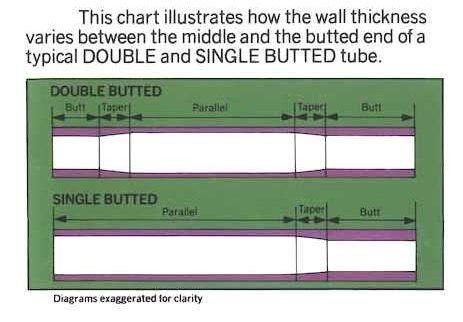
Specs from the 1980 French Gitane catalog showing 7/10 tubing on their top 2 models that year.

Tubing wall thickness specs from the 1974 "Delong's Guide to Bicycles and Bicycling".
These numbers were accurate conversions from BWG (Birmingham Wire Gage used for pipe and tubing wall thickness) or inch dimensions. Tubes were never drawn that accurately so drop the second decimal point e.g. 1.02/0.71 = 1.0mm x 0.7mm thickness

1mm x .7mm thick butted main tubes were standard on many factory frames from as far back as the 1950's up into the 1980's, including most Peugeot PX-10s.
Relatively speaking, Columbus SP was considered "heavy gauge" tubing. But, Reynolds 531 7/10 "Sprint" tubing which was the same thickness was not - thus the myth that Reynolds was lighter than Columbus... Butted Vitus 172 was also the same 7/10 wall thickness. BTW, most Schwinn Paramounts were made of 7/10 Reynolds 531.
Those 7/10 butted tubes were still considered light weight when compared to the "gas pipe" tubing used in cheap department store bikes and also entry level bikes. They had main tubes ranging from 1.5mm to 3mm+ thick - thus the 40 lb Schwinns!
There were several reasons for using 7/10 tubing vs. thinner tubes on production frames. One, it allowed the use of less skilled workers for brazing together frames because thicker tubes were less susceptible to damage from overheating. Secondly, the thicker tubing was less likely to get damaged by rough handling during production.
Up into the 1980's many pro team bikes were made of 7/10 tubing because the heavier main tubes were more resistant to damage from crashes and rough handling by team support members.
Before riders like Hinault and Lemond came along, team riders, the domestiques, were usually issued one bike for the year. Many of those bikes were repainted and passed on for several years ending up in the hands of espoirs, young riders on training teams.
Columbus SL and Super Vitus 971 main tubes were 6/9 = .6mm x .9mm thick. The forks and stays were thinner too. Reynolds also produced tube sets with those specs. Many of the smaller builders in the UK used Reynolds 531 with 6/9 tubes plus even lighter sets with 5/8 - .5mm x .8mm top and seat tubes.
In the mid 70's the US market started getting flooded with Italian frames. Except for larger sizes most of those frames were being made of "light gauge" Columbus SL tubing.
To be continued...
verktyg

__________________
Don't believe everything you think! History is written by those who weren't there....
Chas. ;-)
Don't believe everything you think! History is written by those who weren't there....
Chas. ;-)
#20
Ride, Wrench, Swap, Race
Join Date: Jan 2010
Location: Northern California
Posts: 9,181
Bikes: Cheltenham-Pedersen racer, Boulder F/S Paris-Roubaix, Varsity racer, '52 Christophe, '62 Continental, '92 Merckx, '75 Limongi, '76 Presto, '72 Gitane SC, '71 Schwinn SS, etc.
Mentioned: 132 Post(s)
Tagged: 0 Thread(s)
Quoted: 1562 Post(s)
Liked 1,285 Times
in
856 Posts
#21
blahblahblah chrome moly
Join Date: Apr 2009
Location: Seattle
Posts: 1,984
Mentioned: 92 Post(s)
Tagged: 0 Thread(s)
Quoted: 1172 Post(s)
Liked 2,566 Times
in
1,072 Posts
The confusion is compounded by the fact that the butt on a 7/10 tube is 1.0 mm, but that's still not what the 10 in 7/10 means. 7/10 is still only talking about the gauge of the thin unbutted part. It's just a coincidence that the butt is ten tenths on that tube. You follow?
To confuse things even more, it's likely that those tubes called 5/10 weren't even 0.5 in the unbutt, they were heavier than that, actually closer to 0.6 mm.
Some French writers used to talk about 531 being available in 3/10, but this is controversial. I think it's likely that Reynolds made tubes to wire gauge thicknesses, even in the metric diameters they made for French framebuilders. The wire gauge thicknesses don't match up very well with tenths of a mm, so for instance when a 21/24 gauge tube is called .8/.5, as they commonly are, that is very far from the truth. 24 gauge is actually about .56, so as you can see it's a little closer to .6 than it is to .5. Calling that 5/10 is a bit dishonest, since bike stuff that's lighter is usually more desirable, and more expensive.
Others say no, the metric 531 tubes were made using tooling owned by the French distributor that Reynolds used for all French tubes, and they specified the thicknesses in tenths of a mm. So maybe a French 5/10 tube really is 0.5 mm in the thin part. I don't know, not taking a side in this argument. I do have some metric 753, so maybe I'll go measure it.
Later (early '80s maybe), Reynolds started marking their tubes (even the inch-based sizes like 1-1/8") in tenths of a mm. I don't know if this means they stopped making them to wire gauge thicknesses, or maybe they just started calling the old 24 gauge tubes 0.5 mm? Again, dishonest if so.
Nowadays of course Reynolds tubes made in Asia are almost certainly made to tenths of a mm. It would be crazy for tubes made in Asia to be made to wire gauge thicknesses. But I'm guessing. Someone here probably knows for sure. Oh right, see this article written by BF member Kuromori which goes into it in great detail, including whether 3/10 531 ever really existed. Kuromori is of the opinion that the so-called 3/10 was really 0.38 mm, i.e. much closer to 0.4. But no one is going to saw up an old superlight Singer from the Technical Trials to measure the unbutted thickness, so we may never know the answer to that question.
But I digress. My main point is ignore the "/10", in 5/10 -- it is not talking about the gauge of the butt, it just means "tenths".
Mark B in Seattle
Likes For bulgie:
#22
Senior Member
Join Date: Apr 2005
Location: Ann Arbor, MI
Posts: 16,866
Bikes: 1980 Masi, 1984 Mondonico, 1984 Trek 610, 1980 Woodrup Giro, 2005 Mondonico Futura Leggera ELOS, 1967 PX10E, 1971 Peugeot UO-8
Mentioned: 49 Post(s)
Tagged: 0 Thread(s)
Quoted: 1854 Post(s)
Liked 660 Times
in
503 Posts
No, I meant that seat tubes would be (say for Columbus SL) .9/.6, rather than .9/.6/.9, since seat tubes are usually single-butted.
#23
Senior Member
Join Date: Apr 2005
Location: Ann Arbor, MI
Posts: 16,866
Bikes: 1980 Masi, 1984 Mondonico, 1984 Trek 610, 1980 Woodrup Giro, 2005 Mondonico Futura Leggera ELOS, 1967 PX10E, 1971 Peugeot UO-8
Mentioned: 49 Post(s)
Tagged: 0 Thread(s)
Quoted: 1854 Post(s)
Liked 660 Times
in
503 Posts
@bulgie, @dddd, and @verktyg, thanks for all the detail! I was missing that the mid-tube wall thicknesses were being expressed in fractions, while we use similar notation to day to indicate a single-butted tube (i.e. Columbus SL seat tube .9/.6 or 9/6 or 6/9).
Last edited by Road Fan; 05-11-20 at 08:19 AM.
#24
Newbie
Thread Starter
Yes, Thank you for all the detail. I finally removed the freewheel using a punch and hammer and the Park Tool. Progress is slow but at least it's coming along.
I ordered those pulleys for $15 so thanks for the heads up on those.
I'll post pictures once tires are installed.
I ordered those pulleys for $15 so thanks for the heads up on those.
I'll post pictures once tires are installed.
#25
Senior Member
Yes, Thank you for all the detail. I finally removed the freewheel using a punch and hammer and the Park Tool. Progress is slow but at least it's coming along.
I ordered those pulleys for $15 so thanks for the heads up on those.
I'll post pictures once tires are installed.
I ordered those pulleys for $15 so thanks for the heads up on those.
I'll post pictures once tires are installed.

















